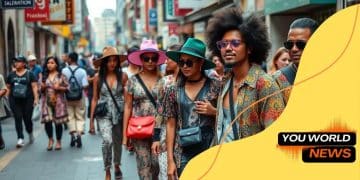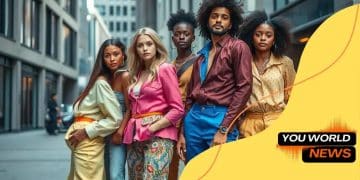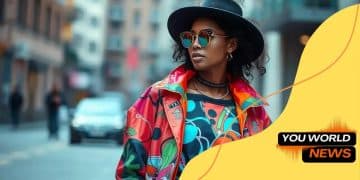How fashion weeks are evolving post-pandemic
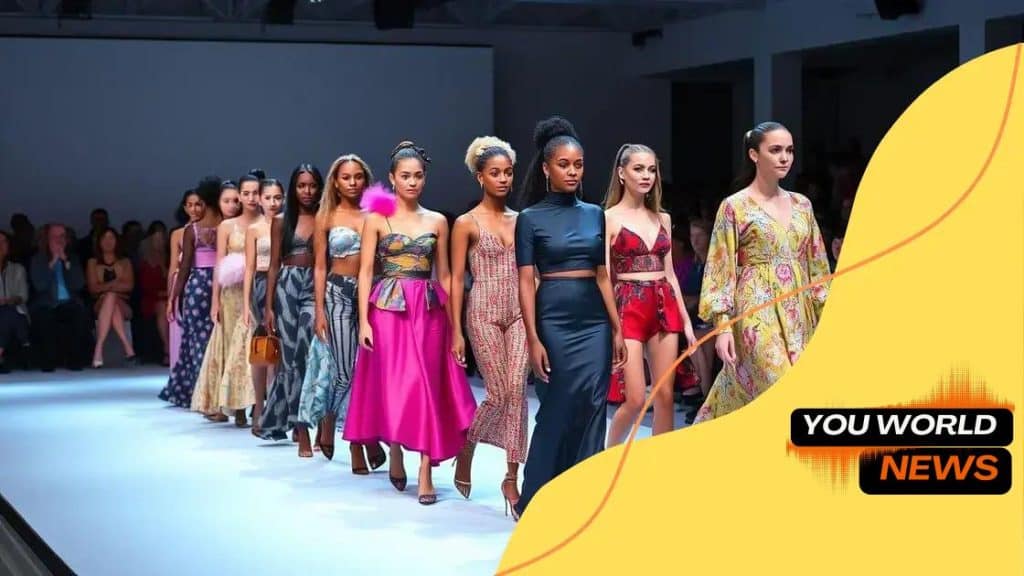
Fashion weeks are evolving post-pandemic by integrating digital technology, emphasizing sustainability, and prioritizing diversity, which together enhance audience engagement and redefine the industry’s future.
How fashion weeks are evolving post-pandemic reflects a significant shift in how the industry showcases creativity. Have you noticed the changes in style and format? Let’s delve into the intriguing transformations.
The impact of COVID-19 on fashion weeks
The impact of COVID-19 on fashion weeks has reshaped the landscape of the fashion industry. With events postponed or canceled, designers were forced to rethink their approaches. Many turned to digital platforms to showcase their collections, leading to a significant shift in the way fashion is presented to the world.
Changes in Scheduling
Traditionally, fashion weeks occurred twice a year, but the pandemic prompted schedules to adapt. Designers and organizers have reconsidered the timing of their shows. This has led brands to organize smaller, more intimate events, allowing for greater focus on each collection.
- Flexible timing for collections
- More localized events
- Smaller audience sizes
Moreover, access to fashion shows increased as they became available online. Virtual events opened doors for many fans who weren’t able to attend live shows in the past. This was a step towards greater inclusivity in the fashion sphere.
Shifts in Trends and Styles
As fashion weeks evolved, so did the items presented. Designers began focusing on comfort and practicality, reflecting the changes in consumer behavior. The pandemic had a lasting impact, driving people to prioritize comfort over extravagant styles. This shift has resulted in a notable increase in demand for casual wear and versatile pieces.
- Rise of loungewear collections
- Focus on sustainable materials
- Incorporation of technology in clothing
To sum up, the impact of COVID-19 on fashion weeks has been profound. The shift towards digital platforms, changes in scheduling, and a focus on comfort are shaping the future of the industry.
Innovative formats replacing traditional shows
Innovative formats are now replacing traditional shows in the fashion industry. As the landscape evolves, designers and brands are looking for new ways to engage with audiences. The pandemic has accelerated this change, pushing many to explore alternatives that are more adaptable and inclusive.
Digital Fashion Shows
One of the most significant shifts has been the rise of digital fashion shows. These online presentations allow designers to reach global audiences without the constraints of physical venues. As a result, consumers around the world can experience the excitement of runway presentations from the comfort of their homes.
- Access to global audiences
- Cost-effective alternatives
- Enhanced viewer engagement
Digital platforms also provide opportunities for interactive experiences. Viewers can interact with the content, learn about the designs in real time, and even purchase items directly from the show.
Hybrid Events
Another approach gaining traction is the hybrid fashion show. By combining both physical and digital elements, brands can deliver an inclusive experience. Guests can attend in person while others participate online.
- In-person experience with a broader audience
- Live streaming for increased reach
- Flexibility in audience participation
This format not only caters to diverse preferences but also keeps fashion accessible during uncertain times. Furthermore, sustainability has taken center stage, encouraging brands to produce fewer physical samples, which is beneficial for the environment.
Overall, the industry is seeing a push towards formats that are not only innovative but also adaptable. This transformation is reshaping the future of how fashion is showcased and experienced around the world.
Sustainability and inclusivity in fashion events
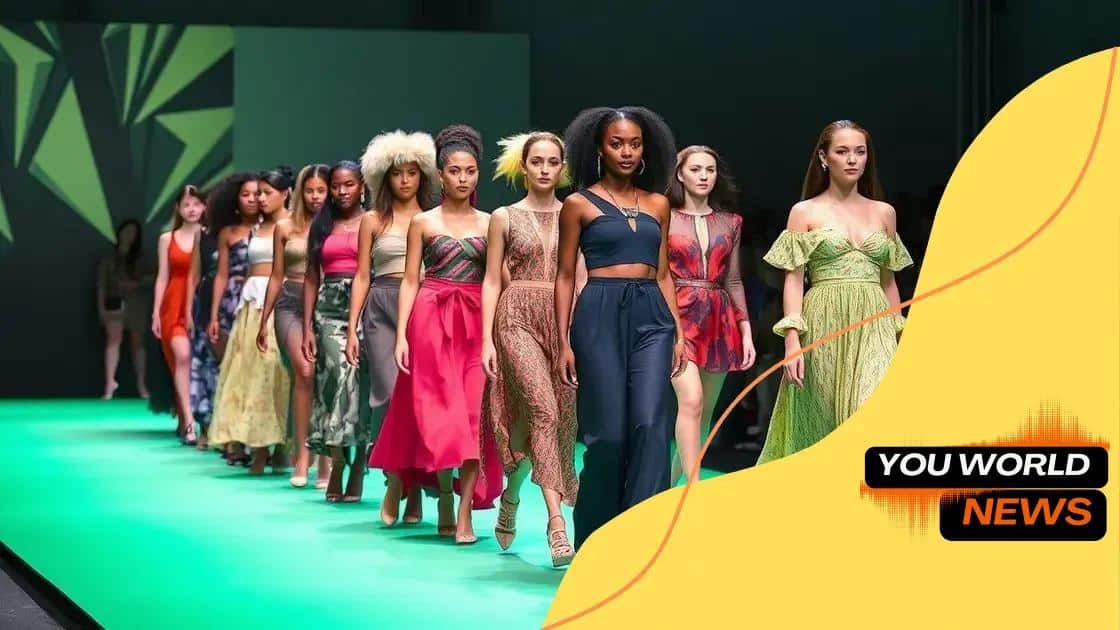
Sustainability and inclusivity are becoming central themes in fashion events today. As the industry faces environmental challenges, brands are acknowledging their responsibility to innovate and adapt. This shift has encouraged a move towards eco-friendly practices that support both the planet and diverse communities.
Eco-Friendly Practices
Many fashion brands are now focusing on sustainable materials. This includes using organic fabrics, recycled materials, and eco-friendly dyes. By prioritizing sustainability, they aim to reduce their environmental impact and promote ethical consumption.
- Use of sustainable fabrics
- Reduction of waste through recycling
- Ethically sourced materials
Additionally, fashion events are taking measures to minimize their carbon footprint. This includes reducing energy consumption, encouraging virtual attendance, and partnering with eco-conscious suppliers. Such actions not only benefit the environment but also resonate with consumers who prioritize sustainability.
Inclusivity in Showcasing Talent
Alongside sustainability, inclusivity is a vital aspect of modern fashion events. The industry is increasingly featuring models of diverse backgrounds, sizes, and abilities. This representation sends a powerful message about acceptance and celebrates the beauty of individuality.
- Representation of different body types
- Showcasing models from various ethnicities
- Highlighting disability inclusion
Moreover, events are offering platforms for emerging designers from underrepresented communities. This helps to amplify diverse voices and perspectives, enriching the fashion narrative.
Overall, the commitment to sustainability and inclusivity in fashion events reflects a broader societal shift. These changes not only help the planet but also foster a sense of belonging and empowerment within the fashion community.
Digital influence on audience engagement
The digital influence on audience engagement has transformed how fashion events connect with viewers. As technology advances, brands and designers are leveraging various digital platforms to create immersive experiences.
Social Media Integration
Social media plays a crucial role in engaging audiences before, during, and after fashion shows. Platforms like Instagram and TikTok allow brands to share live updates, behind-the-scenes content, and interactive polls. This keeps followers excited and involved.
- Live streaming of fashion shows
- Interactive Q&A sessions with designers
- Real-time feedback through comments and reactions
By utilizing hashtags and challenges, brands can boost their visibility and encourage user-generated content. This creates a sense of community around the brand and its events.
Virtual Reality and Augmented Reality
Virtual reality (VR) and augmented reality (AR) technologies provide unique ways for audiences to engage with fashion. These technologies allow fans to experience runway shows as if they were there in person. They can also try on clothes virtually, enhancing the shopping experience.
- 360-degree views of runway shows
- Virtual dressing rooms to try on outfits
- Enhanced storytelling through interactive experiences
This innovative use of technology not only enriches audience engagement but also opens doors for brands to reach global markets. It encourages more people to participate, regardless of their geographical location.
With the growing influence of digital tools, fashion events are evolving into interactive experiences. Engaging an audience through innovative strategies is changing the way we perceive fashion.
Future trends in fashion weeks
The future trends in fashion weeks are poised to reflect a blend of technology, sustainability, and inclusivity. As the industry adapts to changing consumer demands and global challenges, these themes will shape upcoming events significantly.
Increased Digital Integration
Digital tools will continue to redefine fashion weeks. Expect more brands to utilize live streaming and virtual reality experiences to engage audiences. This allows viewers from around the world to participate in shows without being physically present.
- Virtual runway shows will become standard.
- Augmented reality will enhance viewer engagement.
- Interactive platforms will facilitate direct shopping.
By capitalizing on these technologies, brands can reach wider audiences while making their showcases more accessible and exciting.
Sustainability as a Core Value
Sustainability will remain a driving force in the fashion industry. Future fashion weeks will emphasize eco-friendly practices throughout the planning and execution stages. Expect to see more collections made from recycled or organic materials.
- Fashion events will highlight brands committed to sustainability.
- Showcasing upcycled designs will be common.
- Reducing waste in production and packaging will gain attention.
As consumers become more aware of their impact, brands that prioritize sustainability will stand out.
Diversity and Inclusion
In the coming years, the push for diversity and inclusion will take center stage at fashion weeks. This means greater representation of models from various backgrounds, shapes, and sizes. The industry aims to enhance visibility for underrepresented groups.
- Fashion shows will embrace models of all ethnicities.
- Plus-size representation will grow significantly.
- Disability inclusion will be championed.
This shift not only acknowledges societal changes but also fosters a more inclusive environment in fashion.
Overall, these future trends illustrate an exciting evolution in the fashion industry, creating a more interactive, sustainable, and diverse space for brands and consumers alike.
In conclusion, the fashion industry is undergoing significant changes that will shape the future of fashion weeks. The increased integration of digital technology, commitment to sustainability, and focus on diversity will redefine how we experience fashion. As brands embrace these trends, they not only respond to consumer demands but also create a more inclusive and engaging environment. Together, these elements will play a crucial role in driving the evolution of fashion and establishing a more vibrant and responsible industry.
FAQ – Frequently Asked Questions about the Evolution of Fashion Weeks
How has digital technology changed fashion weeks?
Digital technology allows brands to engage global audiences through live streaming, virtual reality experiences, and social media integration.
What role does sustainability play in modern fashion events?
Sustainability is increasingly important, with brands prioritizing eco-friendly materials and practices to reduce their environmental impact.
Why is diversity inclusion important in fashion weeks?
Diversity inclusion promotes representation from various backgrounds, enhancing the industry’s commitment to acceptance and empowerment.
What are some future trends to expect in fashion weeks?
Expect greater digital integration, a focus on sustainability, and increased representation and inclusivity among models and designers.
